Themed collection Celebrating 50 years of Professor Fred Wudl’s contributions to the field of organic semiconductors

Fred Wudl's fifty-year contribution to organic semiconductors
Guest editors Qichun Zhang, Dmitrii Perepichka and Zhenan Bao introduce this Journal of Materials Chemistry C themed issue on organic semiconductors, in celebration of Professor Fred Wudl's fifty-year contribution to the field.

J. Mater. Chem. C, 2018,6, 3483-3484
https://doi.org/10.1039/C8TC90055H
Organic electronics by design: the power of minor atomic and structural changes
Case studies of minor structural variations highlight the fundamental relationship between structure and function to offer design rules with which to develop the next generation of organic electronic materials.
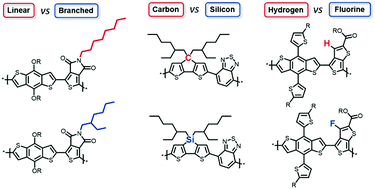
J. Mater. Chem. C, 2018,6, 3564-3572
https://doi.org/10.1039/C7TC05052F
One-dimensional conjugated polymer nanomaterials for flexible and stretchable electronics
Recent development of one-dimensional conjugated polymer nanomaterials for flexible and stretchable electronics and their perspectives are introduced in this study.
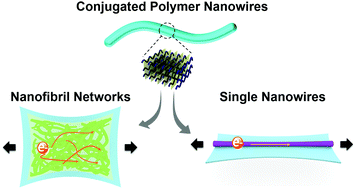
J. Mater. Chem. C, 2018,6, 3538-3550
https://doi.org/10.1039/C7TC05927B
Modification of acenes for n-channel OFET materials
Various strategies to chemically modify acenes for n-channel OFETs are discussed. Such strategies could also be useful for design of efficient n-type organic semiconductors based on other π-systems.
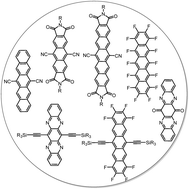
J. Mater. Chem. C, 2018,6, 3551-3563
https://doi.org/10.1039/C8TC00146D
Development of fullerenes and their derivatives as semiconductors in field-effect transistors: exploring the molecular design
A review to explore how to design fullerenes and their derivatives as semiconductors in field-effect transistors.
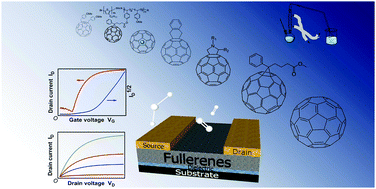
J. Mater. Chem. C, 2018,6, 3514-3537
https://doi.org/10.1039/C7TC05079H
Recent advances in organic near-infrared photodiodes
Both broadband and narrowband organic photodetectors can be realized due to the easily tunable optical/electronic properties of organic semiconductors.
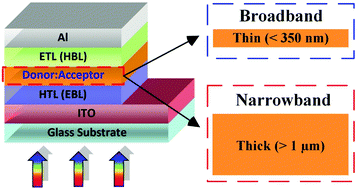
J. Mater. Chem. C, 2018,6, 3499-3513
https://doi.org/10.1039/C7TC05042A
Recent progress on organic donor–acceptor complexes as active elements in organic field-effect transistors
The recent progress on the methods to prepare donor (D)–acceptor (A) co-crystals and their potential applications in OFETs has been reviewed.
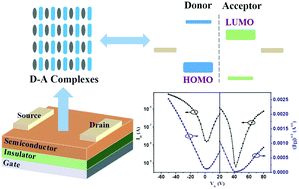
J. Mater. Chem. C, 2018,6, 3485-3498
https://doi.org/10.1039/C7TC04389A
Molecular engineering of phosphacycle-based thermally activated delayed fluorescence materials for deep-blue OLEDs
Deep-blue thermally activated delayed fluorescence materials based on dibenzo-fused phosphacycles are developed.
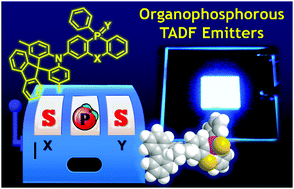
J. Mater. Chem. C, 2018,6, 3578-3583
https://doi.org/10.1039/C7TC05709A
Synthesis, crystal structure, magnetic and electronic properties of the caesium-based transition metal halide Cs3Fe2Br9
A 0D perovskite-related material Cs3Fe2Br9 is shown to have a low bandgap of 1.65 eV and exhibit antiferromagnetic behaviour.
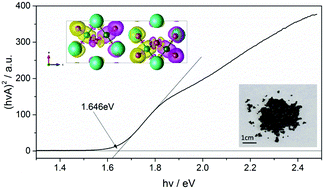
J. Mater. Chem. C, 2018,6, 3573-3577
https://doi.org/10.1039/C7TC04798C
Solution-processed broadband polymer photodetectors with a spectral response of up to 2.5 μm by a low bandgap donor–acceptor conjugated copolymer
Solution-processed polymer PDs with a spectral response ranging from 350 nm to 2500 nm.
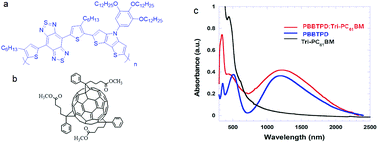
J. Mater. Chem. C, 2018,6, 3634-3641
https://doi.org/10.1039/C8TC00437D
Structure engineering: extending the length of azaacene derivatives through quinone bridges
A novel quinone bridged large azaacene exhibits an electron mobility of 0.22 cm2 V−1 s−1 through molecular stacking structure engineering.
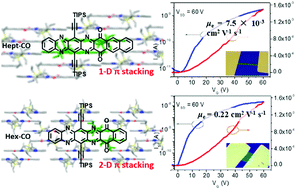
J. Mater. Chem. C, 2018,6, 3628-3633
https://doi.org/10.1039/C8TC00628H
Naphthalimide end capped anthraquinone based solution-processable n-channel organic semiconductors: effect of alkyl chain engineering on charge transport
A series of electron deficient small molecules using fused anthraquinone and naphthalimide conjugated backbone with different alkyl chain length with lower LUMO for n-channel organic thin film transistor.
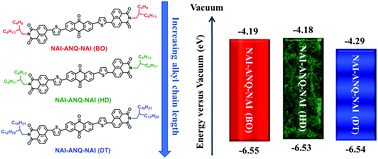
J. Mater. Chem. C, 2018,6, 3774-3786
https://doi.org/10.1039/C7TC05172G
Studies of spin related processes in fullerene C60 devices
We have investigated spin related processes in fullerene C60 devices using a several experimental techniques, which include magnetic field effect of photocurrent and electroluminescence in C60-based diodes; spin polarized carrier injection in C60-based spin-valves; and pure spin current generation in NiFe/C60/Pt trilayer devices.

J. Mater. Chem. C, 2018,6, 3621-3627
https://doi.org/10.1039/C7TC05086K
Face-on vs. edge-on: tuning the structure of tetrathiafulvalene monolayers with solvent
Molecular orientation and supramolecular structure of tetrathiafulvalene derivative on graphite can be controlled by the change of deposition solvent, as revealed by scanning probe microscopy study.
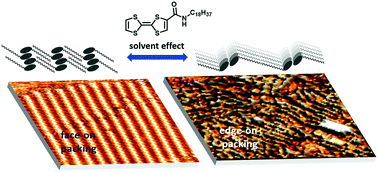
J. Mater. Chem. C, 2018,6, 3787-3791
https://doi.org/10.1039/C7TC05757A
4,5-Diazafluorene co-oligomers as electron-deficient light-emitting materials and selective fluorescence sensors for mercury(II) cations
4,5-Diazafluorene co-oligomers combine improved electron affinity with strong fluorescence and can be used as electron transporting and light-emitting materials, as well as fluorescent sensors for Hg2+ cations.
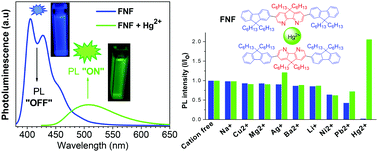
J. Mater. Chem. C, 2018,6, 3762-3773
https://doi.org/10.1039/C7TC05051H
Oxidation of rubrene, and implications for device stability
In studying the formation and thermally activated cycloreversion of oxidized rubrene to pristine rubrene, we observed an irreversible, second stage oxidized product. Understanding the formation of the irreversible adduct will help one design more chemically robust rubrene derivatives.
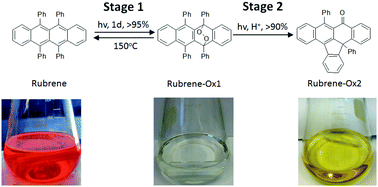
J. Mater. Chem. C, 2018,6, 3757-3761
https://doi.org/10.1039/C7TC05775J
Tuning electrical properties of phenanthroimidazole derivatives to construct multifunctional deep-blue electroluminescent materials
With enhanced electrical properties, TPAPOPPA can deliver decent efficiencies in non-doped, doped, single-layer, yellow and white OLEDs.
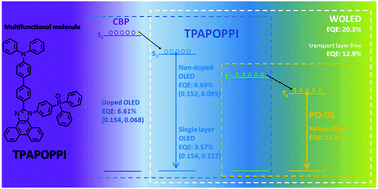
J. Mater. Chem. C, 2018,6, 3584-3592
https://doi.org/10.1039/C7TC04972B
Photophysics and phosphate fluorescence sensing by poly(phenylene ethynylene) conjugated polyelectrolytes with branched ammonium side groups
Conjugated polyelectrolytes (CPEs) have been applied as sensors for various small molecules and ions including biologically important ions.

J. Mater. Chem. C, 2018,6, 3722-3730
https://doi.org/10.1039/C7TC05081J
Thiacycle-fused benzo[1,2-b:4,5-b′]dithiophenes (BDTs): synthesis, packing, molecular orientation and semiconducting properties
Functionalization of benzo[1,2-b:4,5-b′]dithiophenes (BDTs) with thiacycles to selectively tune the packing, molecular orientation and semiconducting properties is systematically studied.
![Graphical abstract: Thiacycle-fused benzo[1,2-b:4,5-b′]dithiophenes (BDTs): synthesis, packing, molecular orientation and semiconducting properties](/en/Image/Get?imageInfo.ImageType=GA&imageInfo.ImageIdentifier.ManuscriptID=C7TC05317G&imageInfo.ImageIdentifier.Year=2018)
J. Mater. Chem. C, 2018,6, 3604-3612
https://doi.org/10.1039/C7TC05317G
3,4-Phenylenedioxythiophenes (PheDOTs) functionalized with electron-withdrawing groups and their analogs for organic electronics
A facile one-pot, microwave-assisted synthesis of novel functionalized arylenedioxythiophenes as promising building blocks for conjugated polymers with tuneable electronic properties is presented.
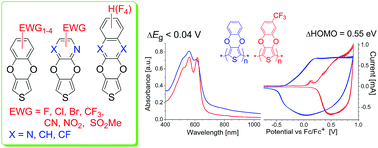
J. Mater. Chem. C, 2018,6, 3743-3756
https://doi.org/10.1039/C7TC05227H
A Friedländer route to 5,7-diazapentacenes
New 5,7-diazapentacene-based materials have been made by means of a Friedländer reaction, which could be promising candidates for optoelectronic applications.

J. Mater. Chem. C, 2018,6, 3715-3721
https://doi.org/10.1039/C7TC05057G
Investigating the effect of heteroatom substitution in 2,1,3-benzoxadiazole and 2,1,3-benzothiadiazole compounds for organic photovoltaics
Subtle changes in the choice of the chalcogen atom in benzochalcogenadiazole ‘small molecules’ can lead to a marked difference in the PCE of bulk heterojunction organic solar cells.
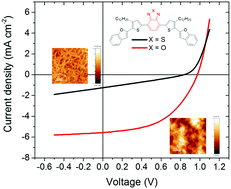
J. Mater. Chem. C, 2018,6, 3709-3714
https://doi.org/10.1039/C7TC05075E
One step facile synthesis of a novel anthanthrone dye-based, dopant-free hole transporting material for efficient and stable perovskite solar cells
A new dopant free stable HTM using anthanthrone dye has been reported with 11.5% efficiency.
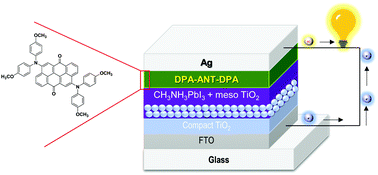
J. Mater. Chem. C, 2018,6, 3699-3708
https://doi.org/10.1039/C7TC05238C
Effects of meso-M(PPh3)2Cl (M = Pd, Ni) substituents on the linear and third-order nonlinear optical properties of chalcogenopyrylium-terminated heptamethines in solution and solid states
Pd(PPh3)2Cl groups hinder aggregation and afford promising solid-state NLO properties.
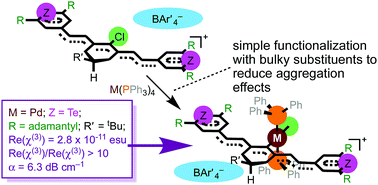
J. Mater. Chem. C, 2018,6, 3613-3620
https://doi.org/10.1039/C7TC05050J
A chrysene-based liquid crystalline semiconductor for organic thin-film transistors
Chrysene and [1]benzothieno[3,2-b][1]benzothiophene possess a similar electronic structure, and chrysene is expected to have better semiconductor device performance than BTBT, owing to the stronger electronic couplings.

J. Mater. Chem. C, 2018,6, 3683-3689
https://doi.org/10.1039/C7TC05063A
Excellent n-type light emitters based on AIE-active silole derivatives for efficient simplified organic light-emitting diodes
New robust n-type light emitters are developed from AIE-active silole derivatives, enabling the OLEDs to operate efficiently in a simplified configuration.
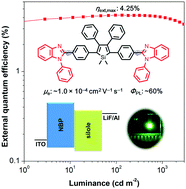
J. Mater. Chem. C, 2018,6, 3690-3698
https://doi.org/10.1039/C7TC05062C
Inversion of charge carrier polarity and boosting the mobility of organic semiconducting polymers based on benzobisthiadiazole derivatives by fluorination
The first fluorinated copolymers based on benzobisthiadiazole (BBT) and its derivatives are newly synthesized, which show an inversion of charge carrier polarity and dramatic improvement of the mobility.
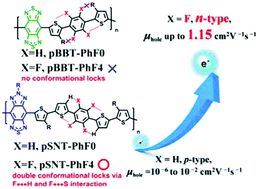
J. Mater. Chem. C, 2018,6, 3593-3603
https://doi.org/10.1039/C7TC04993E
Impact of side chain placement on thermal stability of solar cells in thiophene–thiazolothiazole polymers
We study the impact of side chain placement on the thermal stability of solar cells in thiophene–thiazolothiazole polymers.
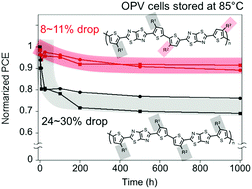
J. Mater. Chem. C, 2018,6, 3668-3674
https://doi.org/10.1039/C7TC04721E
Purely organic materials for extremely simple all-TADF white OLEDs: a new carbazole/oxadiazole hybrid material as a dual-role non-doped light blue emitter and highly efficient orange host
Extremely simple two-color all-TADF WOLEDs with a single-emissive-layer singe-host/dopant system provide a bright future for high-efficiency low-cost vacuum-deposited WOLEDs.
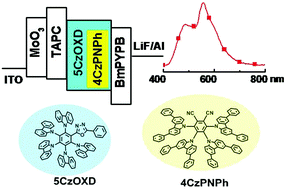
J. Mater. Chem. C, 2018,6, 3675-3682
https://doi.org/10.1039/C7TC04969B
Thermal behaviour of dicarboxylic ester bithiophene polymers exhibiting a high open-circuit voltage
Polythiophene derivatives with ester side chains enable high open-circuit voltages in polymer–fullerene solar cells. The side chains affect the solubility, thermal properties, tendency to aggregate, and photovoltaic performance by modulating the morphology of the blends.

J. Mater. Chem. C, 2018,6, 3731-3742
https://doi.org/10.1039/C7TC04322H
Connecting two phenazines with a four-membered ring: the synthesis, properties and applications of cyclobuta[1,2-b:3,4-b′]diphenazines
This study puts forth a new π-electron molecular scaffold containing two phenazine moieties connected by a four-membered ring. It exhibits interesting optical and electronic properties and sheds light on the role of the four-membered ring in conjugation.
![Graphical abstract: Connecting two phenazines with a four-membered ring: the synthesis, properties and applications of cyclobuta[1,2-b:3,4-b′]diphenazines](/en/Image/Get?imageInfo.ImageType=GA&imageInfo.ImageIdentifier.ManuscriptID=C7TC04092J&imageInfo.ImageIdentifier.Year=2018)
J. Mater. Chem. C, 2018,6, 3651-3657
https://doi.org/10.1039/C7TC04092J
Characterization of the structural, mechanical, and electronic properties of fullerene mixtures: a molecular simulations description
We investigate mixtures of fullerenes and fullerene derivatives, the most commonly used electron accepting materials in organic solar cells, by using a combination of molecular dynamics and density functional theory methods.
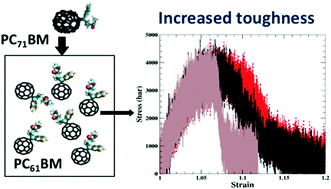
J. Mater. Chem. C, 2018,6, 3642-3650
https://doi.org/10.1039/C7TC03820H
4H-1,2,6-Thiadiazine-containing donor–acceptor conjugated polymers: synthesis, optoelectronic characterization and their use in organic solar cells
A 4H-1,2,6-thiadiazine motif as a new acceptor for D–A conjugated polymers.
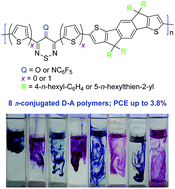
J. Mater. Chem. C, 2018,6, 3658-3667
https://doi.org/10.1039/C7TC03889E
About this collection
Celebrating 50 years of Professor Fred Wudl’s contributions to the field of organic semiconductors
Guest edited by Qichun Zhang, Nanyang Technological University, Dmitrii Perepichka, McGill University, and Zhenan Bao, Stanford University.
This themed issue of Journal of Materials Chemistry C celebrates fifty years of Professor Fred Wudl’s contributions to the field of organic semiconductors.
Including friends and former co-workers, the issue covers all aspects of organic semiconductors, including experimental and theoretical investigations, properties and applications.